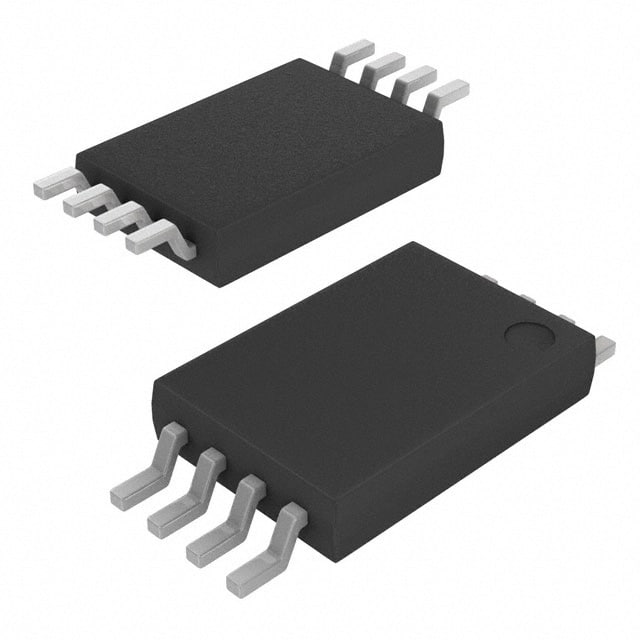AT93C66A-10TI-2.7-T
Product Overview
Category
AT93C66A-10TI-2.7-T belongs to the category of electrically erasable programmable read-only memory (EEPROM) chips.
Use
This product is commonly used for non-volatile storage in various electronic devices, such as microcontrollers, automotive systems, and consumer electronics.
Characteristics
- Non-volatile: The data stored in AT93C66A-10TI-2.7-T remains even when power is removed.
- Electrically erasable: The memory can be erased and reprogrammed electronically.
- High endurance: AT93C66A-10TI-2.7-T offers a high number of write/erase cycles.
- Low power consumption: This chip operates at a low voltage, making it energy-efficient.
Package
AT93C66A-10TI-2.7-T is available in a small surface-mount package, typically a Thin Small Outline Package (TSOP).
Essence
The essence of AT93C66A-10TI-2.7-T lies in its ability to provide reliable and non-volatile storage for electronic devices, ensuring data integrity even during power loss or system shutdown.
Packaging/Quantity
AT93C66A-10TI-2.7-T is usually packaged in reels or tubes, with a typical quantity of 2500 units per reel.
Specifications
- Operating Voltage: 2.7V to 5.5V
- Memory Size: 4Kbits (512 x 8 bits)
- Interface: Serial Peripheral Interface (SPI)
- Operating Temperature Range: -40°C to +85°C
- Write Time: 5ms (typical)
- Data Retention: 100 years (minimum)
Detailed Pin Configuration
- Chip Select (CS)
- Serial Clock (SCK)
- Serial Data Input (SI)
- Serial Data Output (SO)
- Write Enable (WE)
- VCC (Power Supply)
- Ground (GND)
Functional Features
- Sequential Read and Write Operations: AT93C66A-10TI-2.7-T supports both sequential read and write operations, allowing efficient data transfer.
- Software Protection: This chip provides software protection mechanisms to prevent unauthorized access or modification of stored data.
- Hardware Write Protection: AT93C66A-10TI-2.7-T includes hardware write protection pins to disable write operations, ensuring data integrity.
Advantages and Disadvantages
Advantages
- Non-volatile storage ensures data retention even during power loss.
- High endurance allows for frequent write/erase cycles.
- Low power consumption makes it suitable for battery-powered devices.
- Compact package size enables integration into space-constrained designs.
Disadvantages
- Limited memory size may not be sufficient for certain applications requiring larger storage capacity.
- Slower write time compared to some other EEPROM chips on the market.
Working Principles
AT93C66A-10TI-2.7-T utilizes an electrically erasable floating-gate technology. The memory cells store data as charges in a floating gate, which can be electrically programmed or erased. The chip communicates with the host device through the SPI interface, enabling read and write operations.
Detailed Application Field Plans
AT93C66A-10TI-2.7-T finds application in various fields, including: 1. Microcontrollers: Used for storing firmware, configuration data, and calibration parameters. 2. Automotive Systems: Employed in electronic control units (ECUs) for storing critical data, such as vehicle identification information and fault codes. 3. Consumer Electronics: Integrated into devices like smart TVs, set-top boxes, and digital cameras for storing user preferences, settings, and firmware updates.
Detailed and Complete Alternative Models
- AT93C46A-10PU-2.7: Similar to AT93C66A-10TI-2.7-T but with a smaller memory size of 1Kbits.
- AT93C86A-10SU-2.7: Offers a larger memory size of 16Kbits, suitable for applications requiring more storage capacity.
In conclusion, AT93C66A-10TI-2.7-T is an electrically erasable programmable read-only memory (EEPROM) chip that provides reliable non-volatile storage for various electronic devices. With its compact package, low power consumption, and high endurance, it offers advantages in terms of data integrity and energy efficiency. However, its limited memory size and slower write time should be considered for specific application requirements.
قم بإدراج 10 أسئلة وإجابات شائعة تتعلق بتطبيق AT93C66A-10TI-2.7-T في الحلول التقنية
Question: What is the AT93C66A-10TI-2.7-T?
Answer: The AT93C66A-10TI-2.7-T is a serial EEPROM (Electrically Erasable Programmable Read-Only Memory) chip manufactured by Microchip Technology.Question: What is the purpose of the AT93C66A-10TI-2.7-T in technical solutions?
Answer: The AT93C66A-10TI-2.7-T is commonly used for storing small amounts of non-volatile data in various electronic devices, such as microcontrollers, sensors, and communication modules.Question: What is the storage capacity of the AT93C66A-10TI-2.7-T?
Answer: The AT93C66A-10TI-2.7-T has a storage capacity of 4 kilobits (512 bytes) organized into 128 pages of 32 bytes each.Question: How does the AT93C66A-10TI-2.7-T communicate with other components?
Answer: The AT93C66A-10TI-2.7-T uses a simple 3-wire serial interface (SI, SO, and SCK) to communicate with microcontrollers or other devices.Question: What is the operating voltage range of the AT93C66A-10TI-2.7-T?
Answer: The AT93C66A-10TI-2.7-T operates within a voltage range of 2.7V to 5.5V.Question: Can the AT93C66A-10TI-2.7-T be reprogrammed multiple times?
Answer: Yes, the AT93C66A-10TI-2.7-T supports multiple reprogramming cycles, making it suitable for applications that require frequent data updates.Question: Does the AT93C66A-10TI-2.7-T have any built-in security features?
Answer: No, the AT93C66A-10TI-2.7-T does not have built-in security features. If data security is required, additional measures need to be implemented by the system designer.Question: What is the maximum clock frequency supported by the AT93C66A-10TI-2.7-T?
Answer: The AT93C66A-10TI-2.7-T can operate at a maximum clock frequency of 5 MHz.Question: Can the AT93C66A-10TI-2.7-T withstand harsh environmental conditions?
Answer: The AT93C66A-10TI-2.7-T is designed to operate within industrial temperature ranges (-40°C to +85°C) and is capable of withstanding typical environmental conditions.Question: Are there any specific programming requirements for the AT93C66A-10TI-2.7-T?
Answer: Yes, the AT93C66A-10TI-2.7-T requires specific programming commands and protocols to read from or write to its memory. These details can be found in the datasheet provided by Microchip Technology.


